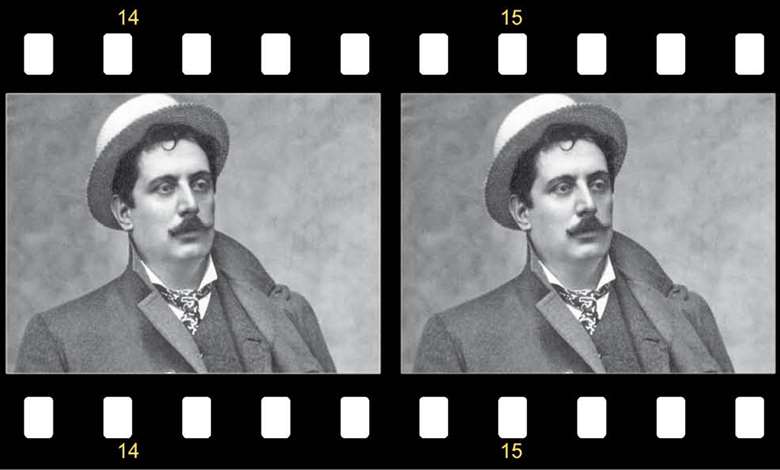Puccini and the Cinema
Ian Haydn Smith
Tuesday, February 9, 2016
Ian Haydn Smith traces the use of Puccini's music through movie history, from You Said a Mouthful in 1932 to Mission: Impossible – Rogue Nation

Opera has a long and rich relationship with cinema. There are the countless film adaptations that run the gamut from the traditional to more radical fare. The best of them include Powell and Pressburger’s glorious The Tales of Hoffman (1951), Hans-Jurgen Syberberg’s experimental Parsifal (1982), Joseph Losey’s stunning Don Giovanni (1979), Francesco Rosi’s hugely popular Carmen (1984), the many Franco Zefferelli productions – of which 1982’s La Traviata is perhaps the finest – and Ingmar Bergman’s sublime The Magic Flute (1975).
Opera has also been a mainstay of many a classic film soundtrack. It is unlikely that the famous helicopter scene in Apocalypse Now (1979) would have had the same impact if Wagner’s ‘Ride of the Valkyries’ had not been accompanying the attack. Nor would Malone’s death scene in The Untouchables (1987) be quite as powerful if it weren’t played out to the strains of Leoncavallo's ‘Vesti La Giubba’. But what of Puccini’s contribution to cinema?
The composer’s first encounter with the nascent art form was less than auspicious. Al Jolson, Buddy DeSylva and Vincent Rose’s popular song ‘Avalon’, which the Puccini estate took to court in 1921 and from which they were awarded royalties due to the tune’s similarity to ‘E lucevan le stelle’, first appeared in the forgettable Joe E. Brown and Ginger Rogers vehicle You Said a Mouthful (1932). It also featured in a range of films over the next two decades, from the forgotten western King of the Lumberjacks (1940) to such classics as It’s a Wonderful Life (1946), Dark Passage (1947) and East of Eden (1955). As for the aria that inspired the song, it was best used in Sidney Lumet’s gritty cop drama Serpico (1973) and Sylvester Stallone’s Rocky Balboa (2006), the surprisingly good fifth sequel in the boxing franchise.
Puccini’s swooning romanticism, tempered by a fatalism that gives his work such tragic weight, has offered directors the perfect soundtrack for accentuating the heightened drama of a scene; or even offering a counterpoint to the action. Manon Lescaut’s gorgeous ‘Sola Perduta Abandonnato’ was arranged for guitar and helped reinforce a theme of longing in James Gray’s Two Lovers (2008). By contrast, Meir Zarchi’s notorious 1978 rape revenge shocker I Spit on Your Grave made extraordinary use of the aria in one of the film’s most uncomfortable scenes.
The tragedy at the heart of Madame Butterfly became both soundtrack and theme to Adrian Lynne’s hugely popular mainstream thriller Fatal Attraction (1987). In the same year, La Boheme channelled the blossoming romance – certainly more promising than the opera’s – in Norman Jewison’s Moonstruck. La Boheme was also used to stunning effect in Werner Herzog’s epic Fitzcarraldo (1982) and was the source material for Baz Lurhmann’s intoxicating exercise in sensory overload, Moulin Rouge (2001). Madame Butterfly, meanwhile, has underpinned the passions of Michael Caine’s adulterer in Woody Allen’s Hannah and Her Sisters and Bob Hoskins' minder in Neil Jordan’s Mona Lisa (both 1986). More perversely, the opera featured on the soundtrack of Oliver Stone’s Natural Born Killers (1994).
Tosca’s most visible presence in recent cinema was a production of the opera at the open air theatre in Bregenz, Austria, providing the perfect backdrop for the best scene in the otherwise disappointing Bond film Quantum of Solace (2008). While a production of Turandot, this time at the Vienna State Opera, offered up a thrilling set piece in the recent Mission: Impossible – Rogue Nation (2015).
That opera’s most famous aria, ‘Nessun Dorma’, has probably adorned more key scenes in films than any other piece of music. It helped heighten the wickedly supernatural drama of The Witches of Eastwick (1987), added class to the on-pitch antics of Bend It Like Beckham (2002), underpinned the high stakes at play in the otherworldly, monochromatic thriller Suture (1993), and gave voice to the anguish experienced by Javier Bardem’s paraplegic in the Oscar-winning The Sea Inside (2004). The aria’s finest use on screen was in another Oscar-winner, The Killing Fields (1984), accompanying a speech by President Nixon and footage showing the plight of Cambodians under the yolk of Pol Pot’s brutal regime.
‘O Mio Babbino Caro’, the most popular aria from Puccini’s one-act comic opera Gianni Schicchi, may not be as well known as ‘Nessun Dorma’, but its place in film history is secure thanks to two films. It emphasises the yearning of Jack Nicholson’s Mafia hitman, who desires a love greater than life, in John Huston’s brilliant gangster drama Prizzi’s Honor (1985). In the same year, the themes that dominate Puccini’s best-loved operas and the breath-taking beauty that marks his work found their cinematic ideal in Merchant Ivory’s adaptation of E.M. Forster’s Room with a View.
The Italy we see portrayed in the film just wouldn’t look the same without the music of that country’s most romantic composer.
This article was written for the programme of 'Jonas Kaufmann: an Evening with Puccini', which is released in cinemas on February 11. To find your nearest screening and buy tickets please visit the film’s website: jonaskaufmannpuccinifilm.com











